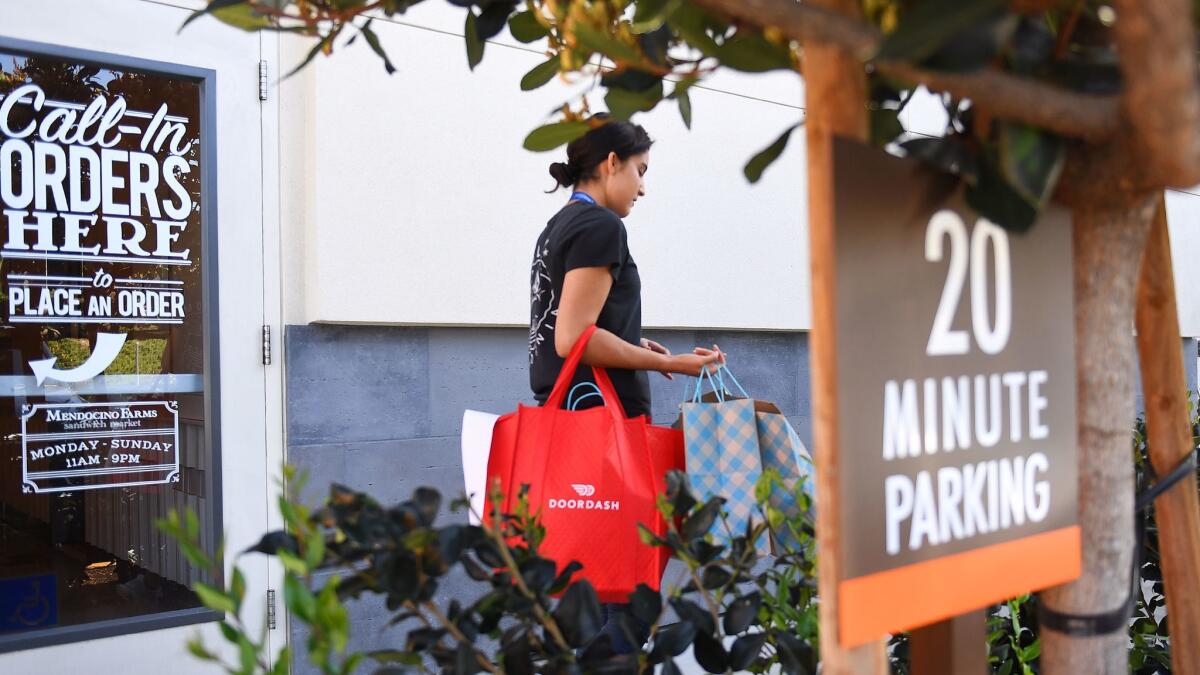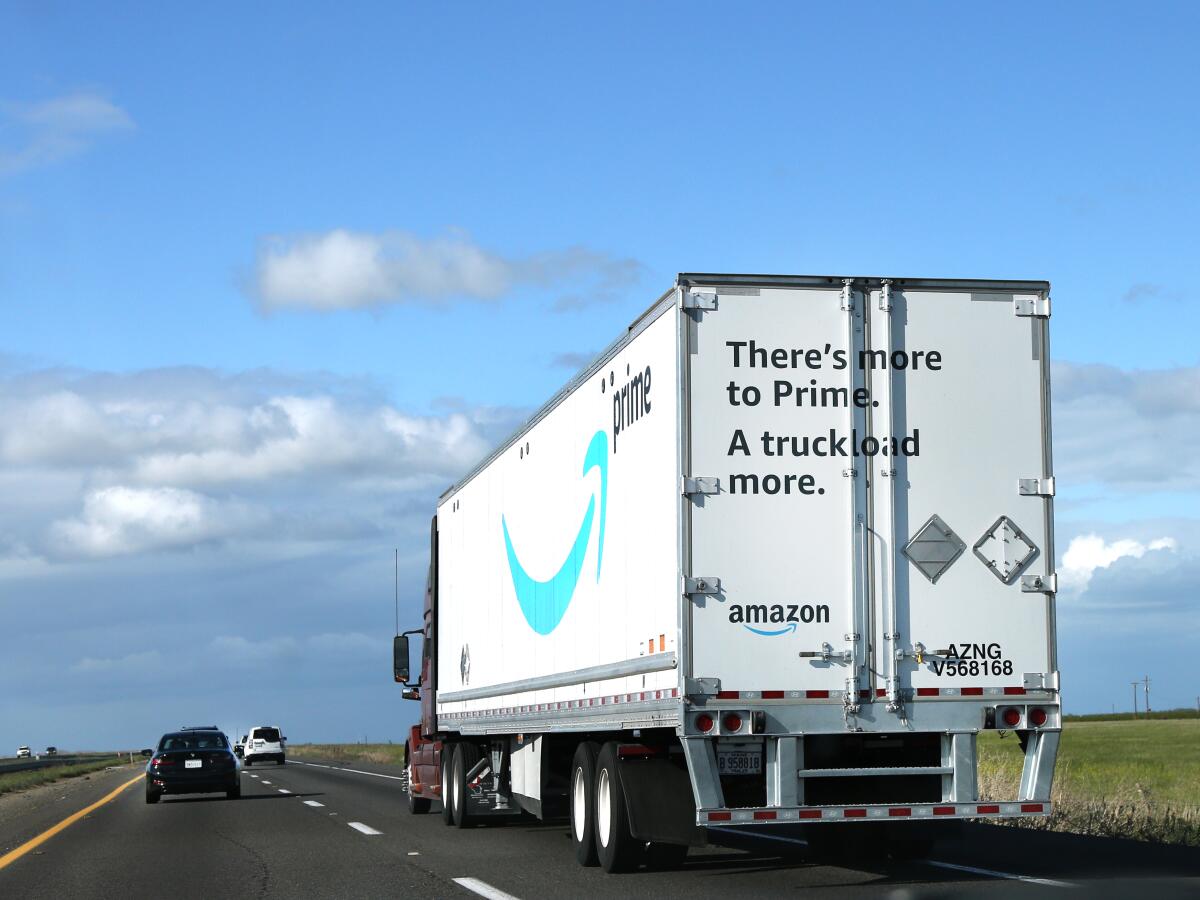Delivery workers are keeping California fed. They say no one’s keeping them safe

- Share via
While most of California hunkered down at home, Toby N. was still delivering meals for DoorDash in the Bay Area town of San Leandro. But days after Alameda County directed its residents to stay home, Toby began experiencing shortness of breath and a dry cough. He went to a doctor on Sunday and was told to self-quarantine for two weeks.
“Patient may return to work on April 3, 2020 pending management of pain and symptoms,” read his doctor’s note, which The Times reviewed. “Patient is instructed to self quarantine to avoid acquiring viral illness or exposure to others.”
Toby relayed the note to the customer support department at DoorDash, expecting to be told he would be compensated for the time off in keeping with a policy the company adopted in early March to prevent potentially contagious workers from infecting customers and restaurant staff.
DoorDash denied his sick pay request on the grounds that his doctor’s note did not explicitly mention COVID-19. Yet it also suspended him for two weeks, without pay, for the safety of “the DoorDash community.”
Toby — who asked that his last name be withheld to protect his professional prospects — is just one of thousands of delivery workers who are providing what the state of California deems an essential service to residents who have been ordered to shelter at home to help curb the spread of the coronavirus. They represent a lifeline for restaurants ordered to discontinue dining service and a workaround for grocery stores required to limit occupancy.
Eager to keep their workforces both calm and healthy, DoorDash, Instacart, Postmates and Uber have all agreed to provide up to two weeks of sick leave to drivers diagnosed with COVID-19 or directed to self-quarantine by a physician.
But several workers told The Times they felt the companies were not offering sufficient protections to help them avoid being infected or compensating them for the health risks involved with hazard pay or raises. In some cases where companies do offer benefits and protections, documents The Times reviewed and driver accounts show they sometimes come with limitations that make them hard to access.
On Monday, workers with the grocery delivery start-up Instacart will hold a nationwide strike and walk off their jobs until the company — which recently said it would hire 300,000 new shoppers to deal with record-high demand — provides free protective equipment, an additional $5 per order in hazard pay, and an extension of the sick leave policy that would go beyond April 8 and would include any worker who has a preexisting condition that’s a known risk factor.
“This sounds dramatic, but I think people are really scared for their lives,” said Sarah Clarke, an organizer with the group behind the Instacart strike. “The corporate workers can work from home safely, but they know shoppers are poor and out there to make $7 per order risking their lives.”
The group accused Instacart of not honoring its sick leave policy and says the qualifications are “virtually impossible to meet.” Instacart spokeswoman Natalia Montalvo did not respond directly to the demands but said the health and safety of the “entire community” was the company’s “first priority.”
“We want to underscore that we absolutely respect the rights of shoppers to provide us feedback and voice their concerns,” Montalvo’s statement read.
Meanwhile, some delivery drivers for Amazon have been provided with safety instructions that fall well short of best practices published by the U.S. Centers for Disease Control and Prevention.
Several documents that The Times reviewed showed that delivery workers around California, including at a Los Angeles-area Whole Foods store, were directed to stay only three feet apart from others as recently as Tuesday. That’s half the distance that the CDC has recommended.

An Amazon spokesperson said it now advises maintaining six feet of distance based on the recommendation of experts. One sign recommending a three-foot buffer also advised drivers to “wash your hands or utilize hand sanitizer daily as needed.”
In a statement, Amazon spokesman Timothy Carter said the company has “worked closely with health authorities to proactively respond…. We have also implemented proactive measures at our facilities to protect employees, including increased cleaning at all facilities, maintaining social distance in our fulfillment centers, and adding distance between drivers and customers when making deliveries.”
Amazon recently said it would hire 100,000 new delivery and warehouse workers and raise wages for all workers in its delivery chain by $2 an hour. But the company’s ability to enforce safety measures throughout its fleet is limited by its extensive use of third-party delivery providers.
One of those providers, Carthago LGX, has presented this raise as a bonus to be doled out to workers who receive high ratings and don’t take sick days, according to internal communications The Times reviewed and online job listings.
A Carthago LGX driver named Tony, who asked that his last name be withheld to avoid possible legal reprisal, said his manager said anyone who called out sick for one day would not be eligible for the “bonus” for the rest of the pay period.
A weekly schedule The Times reviewed supported this account, reading, “we will be compensating employees an extra $2 per scheduled hour (max $16/shift) starting 3/15/2020. Must work the scheduled shift...No call outs and be ‘Fantastic.’”
Carthago LGX did not respond to a voicemail. An Amazon spokesperson said the company has invested $350 million globally to give workers raises and it is not tied to performance, nor is it up to the partners’ discretion.
Tony recently quit his job at Carthago LGX in response to what he described as a lack of concern for employees’ safety. After the company failed to provide masks to delivery drivers, he fashioned his own from rubber bands and a paper towel.
As for Toby, the DoorDash driver, two days after notifying customer support of his illness, he received a reply informing him he’d been deactivated until he could provide proof he had “been cleared of COVID-19” — even though his sick pay claim was denied on the basis that his doctor’s note didn’t mention COVID-19, according to a DoorDash spokeswoman.
The spokeswoman, Becky Sosnov, said the company’s small “task force is actively working to develop and implement a strategy to protect the health and safety of our community in response to the spread of the novel coronavirus.”
For now, Toby is in limbo. He asked his doctor to provide a new note he can send to DoorDash that explicitly cites “COVID-19-related symptoms” and is hoping the company will make an exception to its no-appeals rule. He’s also waiting for the results of a COVID-19 test he took Tuesday at a fire station.
“I’m suffering here because I really need the money,” he said.
Times staff writer Sam Dean contributed to this report.







